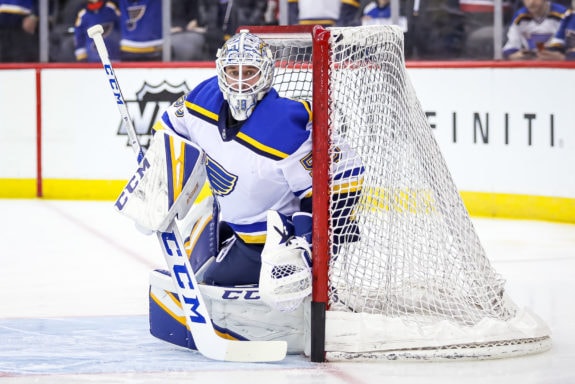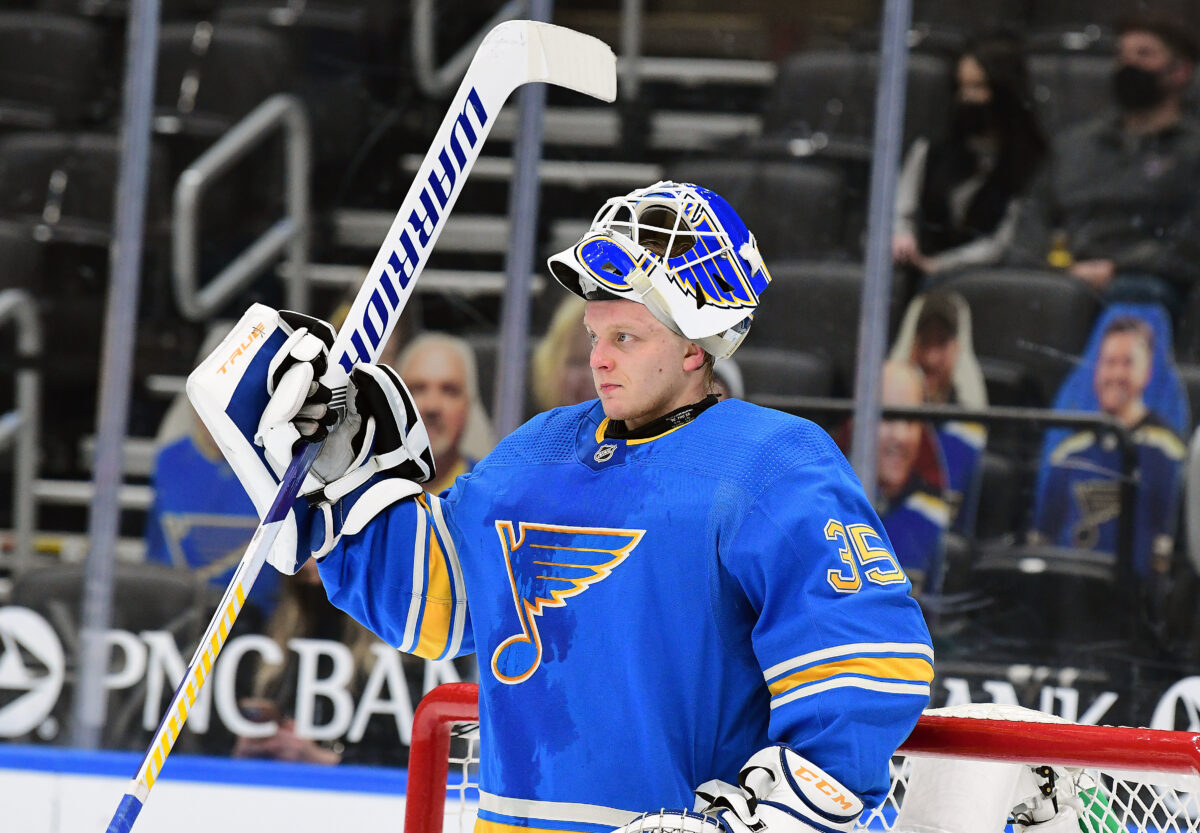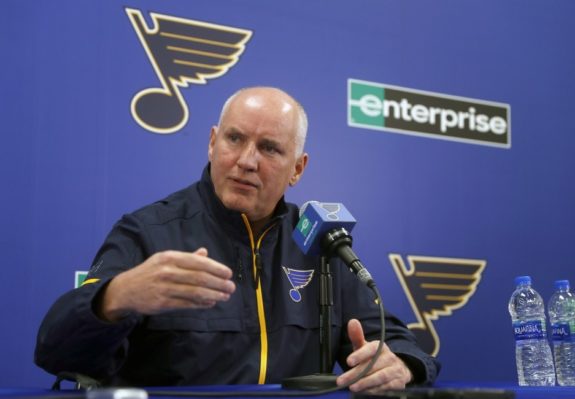The St. Louis Blues recently inked their starting goaltender Jordan Binnington to a six-year, $36 million extension. It seems like their future in the crease is set for now. But goaltending is a notoriously fickle position, and turnover is high. No franchise would be wise not to build a deep goaltending cupboard.
Fortunately, the Blues have done precisely that over time and have made a habit of drafting a goalkeeper almost every season. In this article, we’ll look at every goalie in the system, starting with Binnington, and evaluate their long-term prospects. With their starter secured and plenty of promising prospects, the Blues might be healthier in net than they have ever been.
Jordan Binnington (NHL Starter)
There’s no question that Binnington is the #1 in the franchise, and will be for the foreseeable future. His incredible journey to become a Stanley Cup Champion as a rookie is well-known by now. Since then, he’s been trying to reinforce his reputation and prove his staying power at the highest level. With the contract earlier this month, there are few questions left to be asked.

Some fans are concerned about Binnington’s current numbers. He is 10-10-5 with a .903 save percentage (SV%), a 2.78 goals-against average (GAA), and minus-3.9 goals saved above average (GSAA). It’s certainly worrisome, especially after signing a new deal, but it’s too soon to panic. The team has looked poor in front of him, and top defenseman Colton Parayko has missed much of the season. The Blues will need to make some changes in the offseason, but their goaltender won’t be one of them. He’ll need to be reevaluated behind a presumably reloaded defense in the future.
Ville Husso (NHL Backup)
Ville Husso has bee the expected goalie of the future for a while now, and this season, he’s getting his chance to prove himself as the backup. The team relied on him to step up, but his numbers are pretty poor. He’s 9-6-3, a better winning percentage than Binnington, but beyond that, things don’t look good. Husso holds an .885 SV%, a 3.40 GAA and minus 6.5 GSAA. That’s not even good enough to be a bad NHL backup.

Husso has been subject to the same misfortunes as Binnington, including the loss of Parayko, which has loomed large in the team’s whole season. But the team will need to decide whether they can enter next season with two underperforming goalies hoping for a rebound. He does have one more season left on his current contract, so if the team decides to move on, they will need to trade or cut him. Husso is 26 now, and it’s past time to think of him as a potential future solution in the NHL.
Jon Gillies (Taxi Squad)
The Blues signed Jon Gillies to fill the role of a necessary third goalie in the system due to the oddities of the COVID-19 situation. He has not played a NHL game with the team, and won’t unless one of the goalies suffers a major injury. The team could look to bring him back as an AHL contributor in future seasons, but he doesn’t feature heavily in their long-term plans.
Joel Hofer (Utica Comets)
Few players in the Blues’ system have been worse-affected by the COVID-19 shutdown than Joel Hofer. A 2018 fourth-round pick, he had the size of an NHL prospect at 6-foot-5, but until a midseason trade to the Portland Winterhawks in the 2018-19 campaign, he hadn’t put it all together. But a strong performance in Portland earned Hofer an invite to the 2020 World Junior Championship, and that’s where he broke out into a star.
Hofer was arguably the star of the entire tournament, taking over the Canadian net in an embarrassing loss to Russia, and never letting go. He finished with a 5-0-0 record, one shutout, a .946 SV%, and a 1.30 GAA. It was a fantastic performance that made headlines and caused him to soar in the eyes of many analysts. And, unfortunately, he’s barely played since. COVID-19 shut down the Western Hockey League (WHL) and the Winterhawks a few months later, and Hofer has not found playing time with the Utica Comets this season. It’s a frustrating interruption in a bright young career, but at just 20, he’s got plenty of time to get back on track.
Evan Fitzpatrick (Utica Comets)
Evan Fitzpatrick had a promising junior career in the QMJHL, even winning a QMJHL and Memorial Cup Championship after being traded to the Acadie-Bathurst Titan midseason. But in his professional career since then, he’s looked like a different goaltender, and not in a good way. He had a .901 SV% and a 2.66 GAA in 8 games with the San Antonio Rampage in the 2018-19 season and has looked worse and worse ever since. He hasn’t gotten to play with Utica, either, and at 23, time is evaporating for him to turn things around.
Colten Ellis (Charlottetown Islanders)
Colten Ellis may be the fastest-riser on this list. With recent back-to-back shutouts, he claimed the QMJHL record for career shutouts with 18 and tied the single-season high with 7. Of course, he is playing on a dominant Charlottetown Islanders team that currently sits first in the entire league. But he’s still posted fantastic numbers, with a 1.81 GAA and a .926 SV% in a high-scoring league.
There are some questions about Ellis’s size at just 6-foot-1, but there are no questions about his athleticism. And this season, his inconsistent fundamentals have seemed to round into shape. He’s set an impressive record on a dominant team. The future is bright for him. But there’s still a long road to the NHL for a 20-year-old goalie prospect.
Vadim Zherenko (Dynamo Krasnogorsk)
Of all these goaltending prospects, none has gotten more playing time over the last two seasons than Vadim Zherenko, whom the Blues drafted late in the seventh round (pick #208) in 2019. And he’s making the most of his opportunity. He played three regular season and five postseason games in Russia’s MHL junior hockey league and was absolutely dominant, losing none, posting two shutouts, and maintaining a 0.98 GAA and a .960 SV% in five playoff games. He’s also played much of the season (25 games, four postseason games) in the VHL, most analogous to the American Hockey League (AHL) in North America, and has looked very strong. He’s still just 20, but Zherenko has the size NHL analysts covet and has looked unbeatable for two seasons in Russia’s junior and second-tier professional leagues. Could he become a steal for the Blues and another pillar in the Russian goaltending revolution?
Will Cranley (Ottawa 67’s)
Will Cranley is probably the biggest unknown on this list, as a sixth-round prospect from the Ottawa 67’s. He’s 19 and 6-foot-4, so there’s plenty of potential to develop. His 2019-20 stats were underwhelming on a very good 67’s team, which is a bit concerning, but he was not featured as the team’s starter. Since the season was shortened, he has not been in a competitive game for over a year. So a lot remains to be discovered about the young Peterborough native.
Blues Have Bright Hopes for Future
Goaltending is a constant struggle in the NHL. Unless you are one of the few teams lucky enough to draft an Andrei Vasilevskiy or Connor Hellebuyck level goaltender, chances are you’ve spent some time evaluating your netminders and wondering about the future. Fortunately for the St. Louis Blues and the expert drafting of general manager Doug Armstrong, their future looks secure.

Binnington is locked up for six more seasons. Husso may not develop into the goaltender that the franchise long thought he could be, but he’d be a backup at this point, anyway, and is replaceable. Breakout goalies Hofer and Ellis are the highlights of the franchise’s goaltending depth, but Zherenko is another potential diamond in the rough, and an absolute steal if he develops into something after being chosen late in the seventh round. All in all, it’s a healthy stock of potential future netminders, which means the last line of defense in St. Louis should be secure for a long time.